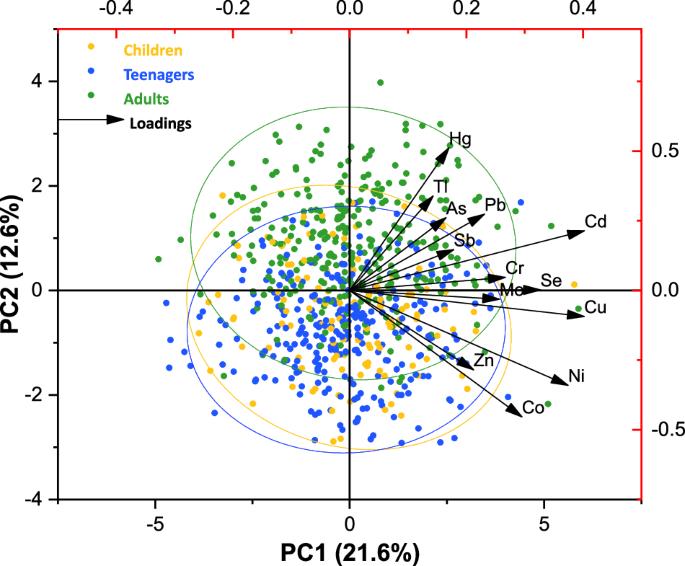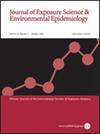Human biomonitoring of essential and toxic trace elements (heavy metals and metalloids) in urine of children, teenagers, and young adults from a Central European Cohort in the Czech Republic
IF 4.7
3区 医学
Q2 ENVIRONMENTAL SCIENCES
Journal of Exposure Science and Environmental Epidemiology
Pub Date : 2024-10-16
DOI:10.1038/s41370-024-00724-4
引用次数: 0
Abstract
Exposure to toxic trace elements, which include metals and metalloids, can induce adverse health effects, including life-threatening diseases. Conversely, essential trace elements are vital for bodily functions, yet their excessive (or inadequate) intake may pose health risks. Therefore, identifying levels and determinants of exposure to trace elements is crucial for safeguarding human health. The present study analyzed urinary concentrations of 14 trace elements (arsenic, cadmium, cobalt, chromium, copper, mercury, manganese, molybdenum, nickel, lead, antimony, selenium, thallium, and zinc) and their exposure determinants in 711 individuals, spanning from children to young adults from a Central European population from the Czech Republic. Multivariate linear regression and non-parametric Kruskal-Wallis ANOVA were used to investigate exposure determinants. Estimates of 95th percentile concentrations and confidence intervals were carried out to establish reference values (RV95). The study also assessed the percentage of population exceeding health-based guidance values (GVs) to gauge health risks. Young adults showed elevated toxic element concentrations, whereas children exhibited higher concentrations of essential elements. Mercury concentrations were associated with both dental amalgam filling count and seafood intake; arsenic concentrations were associated with seafood, rice, and mushroom consumption. Mushroom consumption also influenced lead concentrations. Sex differences were found for cadmium, zinc, nickel, and cobalt. Between 17.9% and 25% of the participants exceeded recommended GV for arsenic, while 2.4% to 2.8% exceeded GV for cadmium. Only one participant exceeded the GV for mercury, and none exceeded GVs for chromium and thallium. Essential trace elements’ GVs were surpassed by 38% to 68.5% participants for zinc, 1.3% to 1.8% for molybdenum, and 0.2% to 0.3% for selenium. The present study examines trace element exposure in a Central European population from the Czech Republic, unveiling elevated exposure levels of toxic elements in young adults and essential elements in children. It elucidates key determinants of trace element exposure, including dietary and lifestyle indicators as well as dental amalgam fillings. Additionally, the study establishes novel reference values and a comparison with established health-based human biomonitoring guidance values, which are crucial for public health decision-making. This comprehensive biomonitoring study provides essential data to inform public health policies and interventions.

对捷克共和国中欧队列中儿童、青少年和年轻人尿液中的必需和有毒微量元素(重金属和类金属)进行人体生物监测。
背景:接触有毒微量元素(包括金属和类金属)会对健康造成不良影响,包括危及生命的疾病。相反,人体必需的微量元素对身体机能至关重要,但摄入过量(或不足)可能会对健康造成危害。因此,确定微量元素的暴露水平和决定因素对于保障人类健康至关重要:本研究分析了捷克共和国中欧地区从儿童到青年的 711 人尿液中 14 种微量元素(砷、镉、钴、铬、铜、汞、锰、钼、镍、铅、锑、硒、铊和锌)的浓度及其暴露决定因素。多变量线性回归和非参数 Kruskal-Wallis 方差分析被用来研究暴露决定因素。对浓度的第 95 百分位数和置信区间进行了估计,以确定参考值 (RV95)。研究还评估了超过健康指导值(GVs)的人口比例,以衡量健康风险:结果:青壮年的有毒元素浓度较高,而儿童的必需元素浓度较高。汞浓度与牙科汞合金填充物数量和海鲜摄入量有关;砷浓度与海鲜、大米和蘑菇摄入量有关。食用蘑菇也会影响铅的浓度。镉、锌、镍和钴的摄入量存在性别差异。17.9%到25%的参与者砷含量超过了建议的GV值,2.4%到2.8%的参与者镉含量超过了GV值。只有一名参与者的汞超过了 GV 值,没有人超过铬和铊的 GV 值。有 38% 至 68.5% 的参与者超过了锌的必需微量元素 GV 值,1.3% 至 1.8% 的参与者超过了钼的必需微量元素 GV 值,0.2% 至 0.3% 的参与者超过了硒的必需微量元素 GV 值:本研究调查了捷克共和国中欧人口的微量元素暴露情况,揭示了青壮年有毒元素和儿童必需元素暴露水平的升高。研究阐明了微量元素暴露的关键决定因素,包括饮食和生活方式指标以及牙科汞合金填充物。此外,该研究还确定了新的参考值,并与既定的基于健康的人体生物监测指导值进行了比较,这对公共卫生决策至关重要。这项全面的生物监测研究为公共卫生政策和干预措施提供了重要数据。
本文章由计算机程序翻译,如有差异,请以英文原文为准。
求助全文
约1分钟内获得全文
求助全文
来源期刊
CiteScore
8.90
自引率
6.70%
发文量
93
审稿时长
3 months
期刊介绍:
Journal of Exposure Science and Environmental Epidemiology (JESEE) aims to be the premier and authoritative source of information on advances in exposure science for professionals in a wide range of environmental and public health disciplines.
JESEE publishes original peer-reviewed research presenting significant advances in exposure science and exposure analysis, including development and application of the latest technologies for measuring exposures, and innovative computational approaches for translating novel data streams to characterize and predict exposures. The types of papers published in the research section of JESEE are original research articles, translation studies, and correspondence. Reported results should further understanding of the relationship between environmental exposure and human health, describe evaluated novel exposure science tools, or demonstrate potential of exposure science to enable decisions and actions that promote and protect human health.

 求助内容:
求助内容: 应助结果提醒方式:
应助结果提醒方式:


